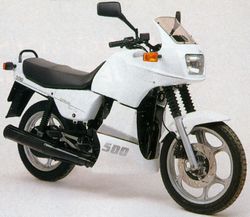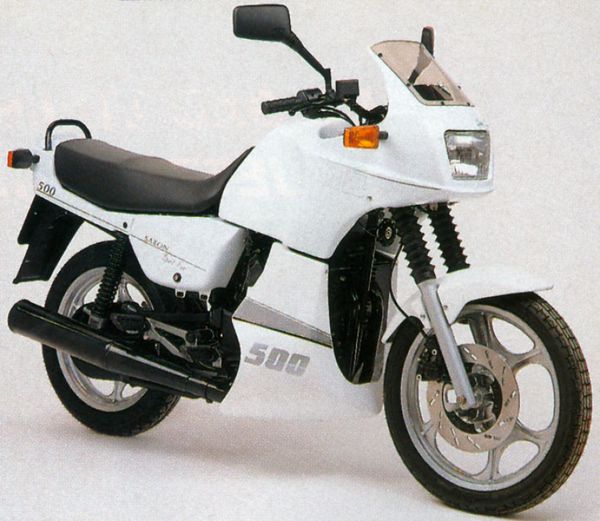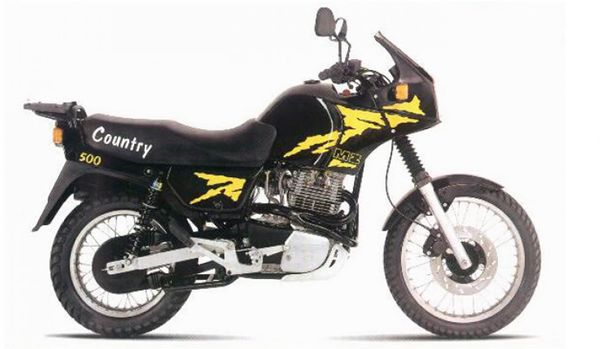MZ / MuZ Saxon 500 Country
 |
|
| MZ / MuZ Saxon 500 Country | |
| Manufacturer | |
|---|---|
| Production | 1993 - 96 |
| Engine | Four stroke, single cylinder. |
| Compression ratio | 9.2:1 |
| Ignition | CDI |
| Transmission | 5 Speed |
| Suspension | Front: Telescopic forks Rear: Dual shocks |
| Brakes | Front: Single 260mm disc Rear: 160mm Drum |
| Front Tire | 100/90 -19 |
| Rear Tire | 120/90 -16 |
| Wheelbase | 1371 mm / 54 in |
| Seat Height | 820 mm / 32.3 in |
| Weight | 149 kg / 328.5 lbs (dry), |
| Fuel Capacity | 23 Liters / 6.0 US gal |
| Manuals | Service Manual |
Engine[edit | edit source]
The engine was a Air cooled cooled Four stroke, single cylinder.. The engine featured a 9.2:1 compression ratio.
Chassis[edit | edit source]
It came with a 100/90 -19 front tire and a 120/90 -16 rear tire. Stopping was achieved via Single 260mm disc in the front and a 160mm Drum in the rear. The front suspension was a Telescopic forks while the rear was equipped with a Dual shocks. The Saxon 500 Country was fitted with a 23 Liters / 6.0 US gal fuel tank. The bike weighed just 149 kg / 328.5 lbs. The wheelbase was 1371 mm / 54 in long.
Photos[edit | edit source]
Overview[edit | edit source]
MuZ Saxon 500 Country
Review
Nice half-liter thumper, this MZ Saxon 500 Country, looking like a somewhat
dated dual-purpose machine, powered by a dependable Rotax single-cylinder
engine. But it was being built in the old East Germany. And to Americans that
aroused suspicion of shoddy work. What gives?
1995 MZ Saxon 500 Country Most motorcyclists will scratch their heads when they hear MZ. Whats that? It was a motorcycle factoryMotorradwerke in Germanin the town of Zschopau, in what used to be East Germany. MZ get it? And Zschopau is in Saxony, one of the 16 German states, hence this motorcycles name. This Saxon 500 story begins shortly after the fall of the wall in Berlin in 1989, but the company actually goes way back to 1906 when a fellow named Rasmussen bought an old factory building and began manufacturing industrial steam fittings. Following World War I, he put his efforts into building a small two-stroke engine that could be attached to a bicycle. This was quite profitable and, by the late 1920s, Rasmussen claimed to be the largest motorcycle manufacturer in the world. World War II came and went, Rasmussen fled west to escape the incoming Russians, while the motorcycle company adapted reasonably well to life under the communist regime. It was building and selling hundreds of thousands of simple, utilitarian two-stroke 125s, similar to Harleys S-models and BSAs Bantams. In 1956, Stalinist marketing types thought that MZ would be a good name should they ever get around to exporting machines. In spite of much criticism concerning socialist economies, MZ did put a lot of time and money into research concerning the improvement of two-stroke technology. The ES125/150 and ETS250 were big hits, with MZ doing well on the European racing scene. After the fall of the wall, MZ got privatized and immediately understood that the West was not interested in buying two-strokesnamely because they were highly illegal polluters. The sensible decision was to get into the four-stroke world as soon as possible, and a deal was made with the Austrian Rotax company for engines. And a formidably reliable engine at that, around since the early 1980s, and much used in Can-Am dirt bikes. The engine was an oversquare unit, an alloy cylinder having an iron sleeve with an 89mm bore, 79.4mm stroke, totaling 494cc. The four-valve head had the sophistication of a belt-driven single overhead camshaft running on reliable ball bearings. A 33mm Bing carburetor fed regular gas to the combustion chamber and its 9.2:1 compression ratio. At 7,000 rpm, the power at the crankshaft was rated at 34 horses, while the rear-wheel stable housed only 28.
Gears ran the power back to a 5-speed gearbox, and from there a chain went to
the rear wheelfully covered, we might add. This had been designed by engineers
accustomed to utility, and an enclosed chain lasted a lot longer than an exposed
one. A modern touch was the electric legbacked up by a kickstarter.
1995 MZ Saxon 500 Country This engine was all new to the workers in Zschopau, but they went to work to fit it into a suitable chassis. A cradle frame held the engine in place, with a box-section backbone holding the three liters of lubricating oil for the dry-sump motor. The swingarm provided mounting places for a pair of West Germanys prestigious Bilstein shock absorbers, although the dual shocks looked more than a little strange in the age of single-shock bikes. For the 35mm front fork, Bilstein also provided the internals. A single disc up front and a drum brake at the back worked effectively. These MZs were really a potpourri of foreign parts: Italian switchgear and disc brakes, a Bosch headlight, Nippondenso ignition, wire wheels from Spain. Knowing that capitalists always liked to have choices, the decision was to make three slightly different variations, beginning with the rather retro-looking Silver Star, having 18-inch wheels fore and aft. Followed by a Tour version with Italian-made cast wheels (18 front, 16 rear) and a quarter fairing/windshield mounted to the handlebar. The one we are looking at is the Country, with spoked wheels, a big six-gallon gas tank, and a small fairing integrated into the tank. The Country was the answer to the growing dual-purpose market, with a 19-inch front wheel, plastic skid plate under the engine, and an upswept exhaust system snaking around behind the engine to emerge on the left side. The low front fender indicated this bike was not intended for serious off-road work, but more for trailingor showing off in town. Wheelbase was a rather short 54 inches, with a dry weight of 335 pounds.
1995 MZ Saxon 500 Country At the top, I noted that the Saxon 500 was made from 1992 to 96but that was for the European market. In this country, an outfit called American Jawa, also with East European connections, was the importer, and the first shipment was of 1995 models. These MZs had an admittedly rather stodgy look about them, and they also suffered a serious pricing problem. The Country was priced at $5,600, while a single-shock Kawasaki KLR650 had a tag of only $4,500. And a heck of a lot more dealers. Next year, the Countrys price got bumped to six grand. After that, the Saxons disappeared. Since then, MZ has had its ups and downs, mostly down, with the company declaring bankruptcy in 2013. Source December 2014 issue of Rider magazine.
| Year | 1993 - 96 |
|---|---|
| Engine Type | Four stroke, single cylinder. |
| Displacement | 494 cc / 30.1 cu-in |
| Bore X Stroke | 89 x 79.4 mm |
| Cooling System | Air cooled |
| Compression | 9.2:1 |
| Induction | Carburetor |
| Ignition | CDI |
| Starting | Electric |
| Max Power | 34 hp / 24.8 kW @ 7000 rpm |
| Max Torque | 35 Nm / 25.8 lb-ft @ 6500 rpm |
| Transmission | 5 Speed |
| Final Drive | Chain |
| Front Suspension | Telescopic forks |
| Rear Suspension | Dual shocks |
| Front Brakes | Single 260mm disc |
| Rear Brakes | 160mm Drum |
| Front Tire | 100/90 -19 |
| Rear Tire | 120/90 -16 |
| Wheelbase | 1371 mm / 54 in |
| Seat Height | 820 mm / 32.3 in |
| Dry Weight | 149 kg / 328.5 lbs |
| Fuel Capacity | 23 Liters / 6.0 US gal |

